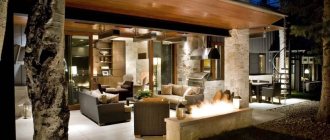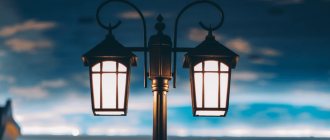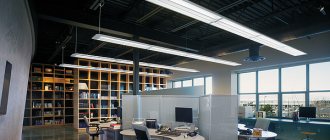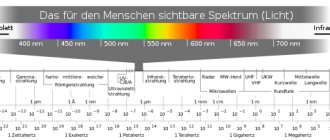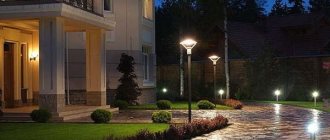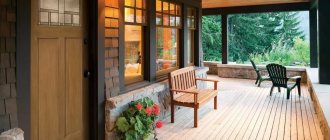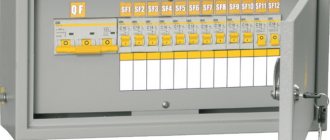Lighting of city streets is necessary to improve visibility at night and increase the safety of drivers and pedestrians. High-quality lighting improves the appearance of the city and has a positive effect on the comfort of residents. Drivers can control the traffic situation much better, and pedestrians can walk without fear of becoming victims of criminals.
City street lighting can be state-of-the-art.
City street lighting concept
Urban lighting is not just about installing lights in poorly lit areas. This part of the work is usually included in the planning of neighborhoods and new streets, it is necessary to carry out wiring and select options that best suit the surrounding environment.
Features and rules of the organization
To ensure high-quality lighting, a number of important aspects must be taken into account. They may vary depending on external conditions and other features. But the main ones are always the same:
- It is necessary to think through the prospects for the development of the microdistrict and the emergence of new buildings. Plan at least 10 years in advance so that you don’t have to redo the lighting plan later.
- The quantity and features of already operating lighting equipment are taken into account. This can either be an addition to existing systems, either with or without modernization, or a complete replacement if it is not possible to combine new and old equipment.
- Select solutions that are suitable for performance and energy efficiency. They must comply with the current technical regulations. Technology is evolving and new options are emerging to further increase efficiency and reduce energy consumption.
- Be sure to take into account the characteristics of streets and objects located nearby. This affects both the method and location of installation, as well as the choice of power and the layout of the correct location.
- Consider the additional capabilities that lighting can perform. For example, when sidewalks are located next to the roadway, lanterns can simultaneously illuminate a road and a pedestrian area.
- Select options that provide the maximum level of security. Fault tolerance and working life are of great importance so that the lights do not have to be constantly maintained.
- A comfortable light environment should be created that fits into the overall urban concept. Very often there is already a ready-made plan that details the requirements for street lighting, which greatly simplifies the design and selection of equipment.
The design of street lighting is included in the general plan of work for the improvement of individual microdistricts.
By the way! When organizing lighting, weather conditions must also be taken into account, as they can significantly impair visibility.
Requirements for utilitarian street lighting
Utilitarian urban street lighting involves the use of lanterns purely for practical purposes. They should provide good visibility of the roadway, pedestrian or courtyard area and highlight particularly dangerous areas that need to be paid attention to. But we cannot lose sight of the aesthetic side, therefore the requirements for utilitarian lighting are as follows:
- The graininess and reflectivity of the road surface is taken into account. This influences the choice of lantern power and the amount needed to achieve the desired effect.
- The arrangement of lamps is selected depending on the width of the roadway. If the road is no wider than 12 meters, it is enough to install lights on one side. In cases where the width is about 18 meters, a staggered arrangement of equipment is used. If there are several lanes and the road is no more than 32 meters in diameter, then a rectangular checkerboard pattern is used.
- With all options for street lighting, it is necessary to take into account the architectural and artistic appearance of the locality. This requirement is specified in paragraph 10.16 of SNiP 2-4-79.
- To illuminate pedestrian crossings, a lamp is placed on each side. An important point here is that the lamp should be on the right side of the pedestrian so that the driver can see him better.
- It is important to consider the amount of precipitation in the region and its nature. Lanterns should provide normal visibility even in the most difficult weather conditions.
An example of how the appearance of a street is transformed when a modern lighting system is installed.
By the way! Light noises should not be overlooked, since in cities there are many billboards, decorative elements for facade lighting, etc.
Which lighting is better - warm or cold?
Color temperature is an important aspect, since urban street lighting is selected taking into account its impact on humans. You can achieve this effect:
- Cold light distorts color reproduction, but it highlights objects much more clearly in the dark and ensures visibility over a long distance. White light improves tone, helps drivers maintain concentration and not be distracted while driving. It is most suitable for highways and pedestrian crossings.
- Warm white light has a yellowish tint, which gives the streets a special coziness and tranquility. Such lanterns are suitable for creating a relaxing environment in pedestrian and park areas.
Cool lighting highlights the roadway and provides excellent visibility.
You should not place both options next to each other, as it does not look very good.
How to understand the types of street lighting
Street lamps are not only a variety of shapes, dimensions, powers, and other parameters, which are quite difficult to get lost in. Therefore, before choosing lamps, let’s understand their types.
Basic comparative characteristics of 6 popular types of lamps:
- Incandescent lamps are a classic that began the history of electric lighting in the mid-19th century. The simple operating principle of heating the filament in an inert gas remains relevant. However, due to the high heat transfer, this type is “crowded out” from the market by more economical options.
- Halogen is a subtype of incandescent lamps. They appeared in the mid-20th century, when halogens (fluorine, chromium, bromine) were added to the incandescent lamp, which allowed the lamp to burn brighter, last longer and get as close as possible to the effect of sunlight. The devices have minor disadvantages, but they do exist: they get very hot and emit ultraviolet radiation. Being near textiles or unstable paint causes the color to gradually fade.
- Gas-discharge (another name for “discharge”) - light is produced by burning natural gas added to the flask. As a result, the device has a service life of up to 20 thousand hours and excellent color rendering. And this is not just an epithet, its indicator is Ra>90. Discharge devices are suitable for outdoor use only. But when installing them, it is worth considering that they practically do not tolerate network interruptions, are more expensive than their halogen counterparts, and are accompanied by flickering and humming, which bothers the eyes. Depending on the additives, this type is divided into mercury, sodium and metal halide.
- Xenon - arc lamps are built into devices of this type. Quite a bright option with a wide spectrum of radiation. They are often used to illuminate highways and roads, where good visibility at night is important.
- Fluorescent - represent a huge category of lighting devices that are used not only for street lighting, but also for homes, aquariums, solariums and other practical and decorative purposes. They are produced in a color temperature range from 2700 K to 6500 K, which means they allow you to create both a more comfortable warm radiation and an accentuating cold one. They have a long service life (about 5 years), although there are cases of failure due to frequent switching on and off.
- Light-emitting diode (LED) - lamps that eliminate the disadvantages of previous options: they do not flicker, do not emit harmful substances, have no restrictions on the number of switches on, and at the same time operate up to 100 thousand hours. Due to their excellent performance characteristics and resistance to the environment, they are used in any outdoor lighting: from installation in the courtyard of a private house to illumination of city parks and roads.
Let us dwell in more detail on LED technology, because it is not for nothing that in European countries the transition to LED street lighting is regulated at the legislative level. Why, given the fairly high cost, is LED more profitable and preferable?
Types of street lighting
There are different types of street lighting and differ in several factors. If you study them, it is easy to understand the features of the equipment and choose an option for any locality.
By purpose
Lanterns are used for different purposes. Each has its own options, and they should be used:
- Models with a reflector concentrate light on a specific section of the road, helping to use the available light flux to the greatest benefit. Due to the location of the lamp at a considerable height, it illuminates a large area of the road and the lamps can be placed at a greater distance from each other. This option is used on highways, city roads and other places with dense traffic flow.
- For less busy roads, options that combine diffuse and reflective lighting are used. Typically, models are used that have a relief lampshade made of transparent material, scattering light over a sufficiently large distance.
- If it is necessary to illuminate sidewalks, pedestrian and bicycle paths, street areas or public transport stops, diffused lighting is used. Most often, lampshades are cylindrical or spherical in shape.
- Backlighting can be used to illuminate signs, markers and other information objects. Most often these are spotlights and lamps, the light of which is directed at a specific object.
The presence of reflectors allows you to direct the light flux specifically to the roadway.
To illuminate other objects, lanterns are selected according to the situation, depending on the requirements of the project.
By type of light source
There are different types of street lights as they use several types of lamps. Each option has its own characteristics that you need to know. The most numerous and widespread group is gas-discharge lamps; they come in three varieties:
- Mercury lamps work by electrically discharging mercury vapor. To operate, you need a starting device; when starting, a certain time is required for warming up and stabilization. During operation, the bulb becomes very hot and the device requires high voltage. If it goes low, the lamp will not start. The glow occurs due to the phosphor that coats the inner walls of the flask.
- Metal halide lamps are characterized by the presence of metal halides in mercury vapor. This ensures high brightness of the lamps and they can illuminate large areas, therefore they are used mainly on open sections of the road. The light temperature is close to natural; this option is increasingly used instead of traditional mercury models.
- Sodium lamps. They work due to the fact that when energy is supplied, a gas discharge is formed in sodium vapor. The equipment provides a warm yellowish light suitable for the design of city streets. With high efficiency, this type requires the creation of optimal working conditions and does not tolerate temperature changes. Therefore, sodium lamps are placed in flasks made of borosilicate glass.
Mercury lamps do not light up immediately; they need some time to warm up.
The video will tell you about the types of street lamps
In addition to gas discharge, many other options are used:
- Incandescent lamps. A traditional solution that is also used for street lighting. Its main advantage is its low price, but at the same time its service life is the shortest and its electricity consumption is high.
- Halogen lamps are an improved type of incandescent lamps in which halogen vapor is pumped inside to improve performance. This improves performance - the light is brighter, and the service life is approximately 2 times longer.
- Xenon options work due to an electric arc that occurs when electricity is supplied to tungsten electrodes. Various compositions are pumped into the flask - from vapors of mercury and sodium salts to inert gases or metal vapors. Depending on the filler, the characteristics change. The models are distinguished by good light, which ensures visibility even in difficult weather conditions.
- Luminescent models are distinguished by high efficiency and low power consumption. Due to the advent of electronic control units, this type began to work much more stable, while the electricity consumption was further reduced and the service life increased. They tolerate frequent switching on and off the worst, so they are suitable for outdoor lighting, where the lights are turned on once a day.
- Induction lamps are classified as gas-discharge lamps. But at the same time, there are no electrodes in the design, which extends the service life of the products, and they retain their original parameters throughout their service life. Light appears due to plasma, which is formed when a high-frequency field is exposed to gas. An inductor is attached to the lamp to ensure normal operation.
- LED equipment. Lamps of this type consume a minimum of electricity, while the light is high-quality and even. The light temperature can be any, it all depends on the diodes used. The lamps are compact and fit into small shades, while the quality of lighting is excellent, the only problem is the high price of the equipment.
LED lights are easy to distinguish by their bright, uniform light and small lampshades.
Typically, one type of lamp is used outdoors to ensure uniform lighting.
By type of support
Lanterns can be mounted on different structures, so there are several main types:
- Concrete pillars are the most common solution used most often. The elements are made of concrete reinforced with metal. A tubular stand or several are usually placed on top for attaching lampshades.
- Metal structures are also well suited for mounting lanterns, as they are lightweight and have high strength. There are different types - for roadways they use more strict options, for pedestrian areas they use supports with forged elements and other decor; they can be either steel or cast iron.
- Wooden poles are almost never used, since the material is not very reliable and lasts less than its analogues. But in some old areas, as well as in villages, they are still preserved.
- Products made from composite materials have appeared recently, but they are being installed more and more often. Such poles are not afraid of moisture and frost, are lightweight and last for decades.
Metal poles are distinguished by strength and durability.
A separate type of lighting is lights on cables stretched between two supports, or on metal crossbars that are fixed between poles on opposite sides of the road. In some cases, equipment is mounted on walls.
By way of managing power supplies
Street lighting can be controlled in different ways; the following types can be distinguished:
- Manual control. In this case, turning on and off is done manually by the operator on a special remote control.
- Automatic control units. With their help, you can program the time to turn on and off the equipment. You can also adjust the brightness of the lights to dim them during certain periods and save electricity.
- Photo relays allow you to turn on the lights at dusk. The system is completely autonomous, it does not need to be adjusted to the seasons, as it reacts to the actual situation.
Options with LED flashlight and solar battery are completely autonomous.
Now there are fully autonomous solar-powered options. They don’t even require wiring; the system stores energy in a battery during the day, and when dusk sets in, the photocell turns on the lighting, which lasts until the next morning.
Recommended viewing:
Features of lighting in city parks and other recreation areas
In this case, the lighting requirements differ from the standard ones. The main attention is paid to the aesthetic side. Light should not only provide good visibility, but also highlight individual elements and emphasize the beauty of nature. There are different solutions used here:
- Sidewalk lights can be in the form of small columns or built-in to illuminate the surface. This is a beautiful solution that highlights the pedestrian paths.
- LED strips and hanging garlands can be mounted both on supports and on trees or any other elements. They not only provide good lighting, but also make the park or recreation area look elegant.
- Hanging lanterns can be installed on any poles, suspended cables or other structures. Well suited for installation on building walls.
- Floodlights located at a height of 3 m and illuminating a site or a separate area in the park. Also, such equipment can focus attention on certain places.
- Lanterns with diffused light shades. Most often these are decorative elements with round shades and yellow light, creating comfortable, calm lighting.
- Various equipment that illuminates individual objects.
Lighting of pedestrian paths and recreation areas has its own characteristics.
Street lighting has specific features, but if you consider them in detail, it is not difficult to understand this type of equipment. It is worth selecting lanterns for specific conditions and taking into account the requirements specified in SNiP and design documentation of the locality.
Features of street lighting
Architectural lighting is now in fashion. In addition to continuous lighting, accent lighting is also used. Lanterns are placed to illuminate doors, columns, niches, and beautiful architectural elements. Contour lighting using LED tubes and cords also looks interesting.
Landscape design also requires proper lighting; in stores you can find lamps of different styles - from classic to high-tech. Contour lighting is used for paths and alleys; floodlights with diffused light are suitable for illuminating the crowns of trees and shrubs. With the help of asymmetrical lamps (located at different heights) you can beautifully play with small architectural forms. Flood lighting is often used to illuminate a large terrace or ponds.
In fact, there should be three backlights. The first is for the perimeter of the site, gates, gates, and entrance doors. The second is for lighting recreation areas - gazebos, patios, pools, barbecue areas, and so on. The third is for paths and paths. In the selection of lamps, every little detail is important, even the spectrum of light: cold shades visually move the illuminated objects away, warm shades, on the contrary, bring them closer. It is recommended to use warm colors to illuminate recreation areas.
When choosing a lamp, you need to take into account not only its design, but also its resistance to adverse external factors - direct rays of the sun, precipitation, wind, dust. The material from which the light source is made must be safe, ease of operation and installation, and service life are equally important.
The main characteristics for street lamps are luminous flux (Lumens) and power (Watts). The higher the ratio of power and luminous flux efficiency, the better the flashlight will shine. Color rendering and chroma, on the contrary, are not so important.

